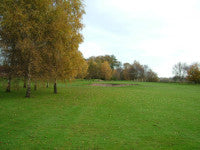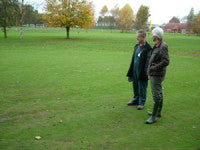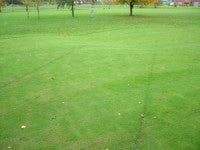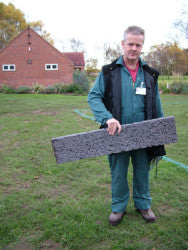Not just a golf course?
Not just a golf course?
By Richard Murray Head Greenkeeper / Instructor- Reaseheath College

My role at Reaseheath College is quite unique. I manage a number of sports facilities including football, rugby, bowls and a short par three nine hole golf course. These facilities are not only used by members of the public and our students for recreation, but are actively used for teaching purposes at the college too. We annually have over 300 students carrying out NVQ levels 2/3 in sports turf management.
The golf course was built twenty years ago and designed to provide a practical teaching environment for students. Each green is constructed using different methods covering a range of soil composition, ranging from total sand construction to total soil pushed up greens. Therefore many of the greens on the course differ in performance and playability.
Now in my third year at Reaseheath, I am beginning to see the quality of our work come into fruition. Many of the greens were in a poor condition when I arrived. By implementing some tried and trusted traditional cultural practices, we have managed to improve sward quality and the porosity of the greens.
I was previously Head Greenkeeper at Sandbach and Izaak Walton Golf Clubs where I began my philosophy on the organic management of golf courses. Fundamental to this policy was restricting the use of pesticides whilst actively promoting and increasing cultural practices such as topdressing and aeration.
I usually apply about 0.5 tons of material per green using a 50/50 ratio of sand to soil dressings throughout the growing season and then apply 100% sand dressing in November.
My aim is to increase microbiological activity in my rootzones and thus help to sustain a healthy environment for the grass plant to survive all the stresses that occur, during a busy playing season. I believe that you have to treat the sward like you would treat yourself - feed yourself on a healthy diet and do not indulge or be excessive in your intake (You are what you eat).
With that in mind, I am a great believer that you must utilise quality products, carry out mechanical operations using the appropriate machinery and ensure you are aware of contemporary advances in education and the practice of turf management. A second opinion can often be very important to justify your actions.
For the last ten years I have worked closely with George Attwood Harris, an agronomist who has always provided me with good advice. George is excellent at listening to my problems and then will advise me of the way forward. He does not tell me "I should do this or do that". It is my decision in the end that matters. It is me who has to take the responsibilities for my actions, not George. I have seen some of the work George has implemented with regard to the organic management of turfgrass facilities. The results have been remarkable. At several courses, George has managed to reduce their applications of fungicides and fertilisers making significant savings for the clubs, and at the same time reducing disease attack."
This was achieved by the methods we are now introducing at Reaseheath.
George and I take a number of soil samples throughout the year, to measure not only nutrient macro and micro levels, but also evaluate the number of bacterial organisms / fungi populations we have in our greens.
EXAMPLE OF A SOIL BIOLOGICAL ANALYSIS REPORT USING ACTUAL DATA GENERATED FOR RICHARD MURRAY AT A PREVIOUS GOLF COURSE
Sampling date :27th of September 1999.
|
Sample Name |
Aerobic Bacteria ('ooos) |
Anaerobic Bacteria ('ooos) |
Yeasts & Fungi ('ooos) |
|
Seventh Green |
340 |
120 |
210 |
|
Eighteenth Green |
600 |
9.7 |
86 |
The numbers in the tables are per gram of soil
Sampling date :28th of September 2001
|
Sample Name |
Aerobic Bacteria ('ooos) |
Anaerobic Bacteria ('ooos) |
Yeasts & Fungi ('ooos) |
|
Seventh Green |
29,000 |
3.2 |
23 |
|
Eighteenth Green |
24,000 |
0.1 |
19 |
AEROBIC BACTERIA
Aerobic bacteria are obvious indicators of a "healthy soil". They will only thrive when there is a good supply of air in the soil. Compacted or waterlogged soils will have a much lower count of aerobic bacteria than well aerated soils.
This is the group of microbes that you strive to encourage in the greens by your aeration work. The results are quite outstanding. The count of aerobic bacteria has increased considerably, from an average of about 500 thousand to an average of over 25 million.
Your challenge now is to maintain the bacteria at these healthy levels. It would be beneficial to continue with the aeration work and your seaweed based fertiliser programme. Also you could include some granular fertilisers with an organic or biological content.
 ANAEROBIC BACTERIA
ANAEROBIC BACTERIA
This group of bacteria has declined significantly as your aeration programme has taken hold. Originally at an average of about 65 thousand, they now average about one thousand. This is also a great result and a tribute to the effort that you have put into the greens.
FUNGI
The fungal count is perhaps the most important as organisms in this group are responsible for the disease seen in the greens. The fungal count has declined as the level of beneficial aerobic bacteria has increased. From an original average of about 150 thousand, the count has reduced to an average of about 20 thousand. More importantly, the greens suffer less from disease which is a considerable cost saving to the club.
CONCLUSION
Overall these results represent a considerable improvement in the health of the greens. They are a testament to the hard work that you have put into changing their management to a more sustainable system. Now this important milestone has been reached, you can move forward as planned with your efforts to improve the quality of the greens' surface
We feed the greens with organic products such as seaweed, which not only provides nutrients for the plant but also helps reduce the incidence of disease. This year disease has been prolific. Many clubs who continue to use fungicides have had heavy disease outbreaks - at Reaseheath we have had just the occasional small patch of disease occurring.
As soon as I see evidence of disease I spray the plant with a small feed of seaweed. (10 litres of seaweed product in 600 litres of water) This usually helps the plant recover. If the disease continues, I apply a dose of acidified water that generally stops the infection. We usually feed the greens with applications of liquid seaweed monthly with light applications of quality fertilizer as and when required.
We would all like Poa free greens. However, we have to manage what we have with the available resources. As we are a teaching resource, I like the course to challenge the students. The fact that we have a wide and varying quality of course is ideal. It allows our students to learn their trade and see for themselves the problems that need addressing when maintaining natural turf.
Currently we are carrying out a drainage trial using Aquadyne a new, recycled drainage medium manufactured by Enconoplas Ltd. One metre long strips made from recycled plastic are moulded to form a free draining material that is inserted into a drain run and acts as a permeable drain.This product has been installed in one of the most problematic greens on the course. The green regularly had ponded water lying on its low plateau. However, since installing Aquadyne we have managed to drain the water away. It will be interesting to see how this product works over time.
The company has also enlisted the help of Reasheath to trial another interesting use of this product. The Aquadyne product will form part of a new pallet system with the aim of seeing how well turf can be grown on it and how well it drains. The potential use of this product for temporary natural tees may be an ideal solution for winter tee mats.
My role at Reaseheath is always very challenging, especially when students are involved. It is vitally important that these students have the opportunity to learn effective skills and gain valuable experience for their work within the sports turf industry. As an assessor and instructor for NVQ courses, I feel it's important that they should attain high standards in both their theory and practical skills.
I do not pass or allow any students through if they do not reach the standards I set myself. I like to know that when we send a student from here into the real working world, they will be more than capable of holding their own in the sports turf industry.
Richard Murray,
Head Greenkeeper and Instructor,
Reaseheath College
Nantwich
Cheshire
CW5 6DF
